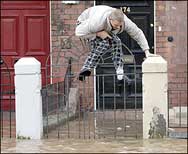
Live above water level
Up to half a million Brits are poised to go off the grid this morning as floods interrupted water supplies and power stations were closed down by water damage. The flooding crisis underlines the need to think carefully when choosing where to live off-grid, as well as the benefits of living off-grid in times of climate change.
Central England is the most affected by the worst flooding in 70 years, with 50,000 people at one point losing both power and water supplies, and 450,000 losing just water. The battle continues to save Walham power station from flooding. If it is forced to close, a further 500,000 will have their power cut off.
The most paradoxical aspect of the crisis is that hundreds of thousands of houses in flooded areas have no drinking water as water treatment plants were shut down. Homes with their own wells or boreholes will have been unaffected, as will homes which do their own rainwater harvesting. Rainwater can be brought to drinking standard with a battery powered ultraviolet (UV) light. Passing the water through a $700 UV gizmo would have been adequate to produce drinking eater for a family, and probably a whole street.
A single 50 Watt solar panel connected to a car leisure battery (total cost approx $500) is enough to power the UV purifier as well as charge batteries for phones and laptops.
Our advice to flood victims and those who fear they may be in an area threatened by floods, is to get off-grid ready: